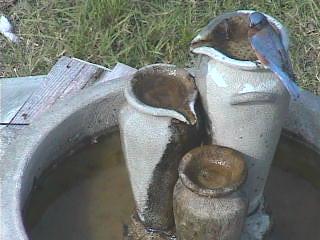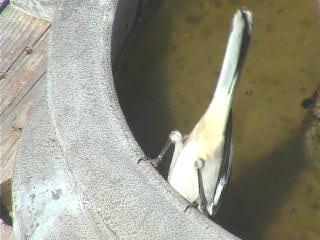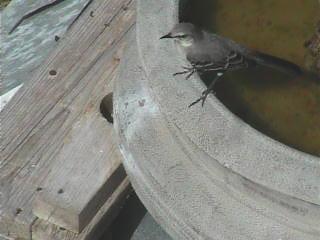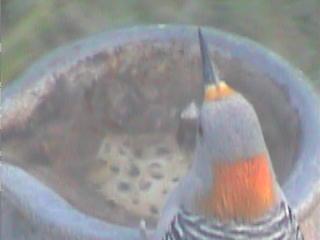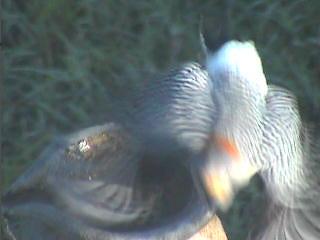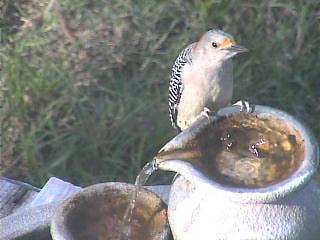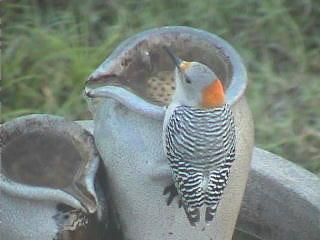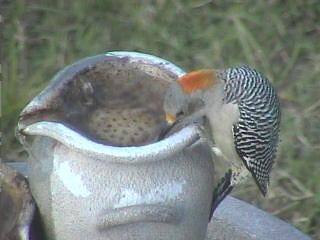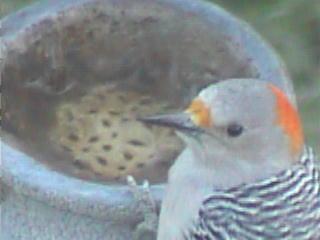The first view I ever had of CONE Welder was the following zoomed-out panorama:
And then there’s that complicated-looking circular object near the center of the field of view. What is that thing? A feeder station? I really want to zoom in on it to get a better idea.
As we all now know, that thing was actually the fountain, with its inverted-cone squirrel guards (I guess?) around the support legs.
For a long time I mostly neglected the fountain; there didn’t seem to be much happening there. I was much more interested in the feeders, and the pond, and that bare-limbed tree beyond the pond to the right. But lately there have been a lot of good birds being photographed at the fountain. Here are some of my favorite shots from the last few days:
The Eastern Bluebird seems to show up here regularly. Here’s a really nice view (of a male, maybe? not sure), taken by txbird at 1:17 p.m. on October 20:
Here’s a two-fer: A Green Jay on the left, and an Audubon’s Oriole in the middle. We’ve only seen Audubon’s Oriole a few times with the camera, so this was definitely an exciting appearance. This shot was taken at 6:49 a.m. on October 21, also by txbird:
Next up are several shots of the Northern Mockingbird, a bird we’ve seen off and on for a while, but have seen a lot of lately at the fountain. The following shots are by, in order, rafa, idbirds, vanilla and tinyang. If you check out the inner toe on the bird’s left foot in each shot, you’ll see that there are at least two mockingirds visiting the fountain: One who is missing that toe, and one who isn’t.
Finally, here are a bunch of my favorite shots of the Golden-fronted Woodpecker, a bird we’ve seen only a few times before its recent run of fountain visits. These are by idbirds, txbird, vanilla, txbird, rafa, and txbird, respectively:
I was chatting recently about all the great fountain shots lately, and wondering if there really are more good birds at the fountain these days, and if so, what caused the change. Or is it that there have always been these good birds there, and we’ve just never bothered to look? I could see an argument being made either way. Birds change their habits in response to seasonal movements and shifting food and water sources and any number of other factors. We’ve certainly seen dramatic changes in the birds visiting the feeders over a similar span of time. So I could easily believe that this recent run of interesting birds at the fountain really is a new phenomenon.
On the other hand, I’ve always been suspicious of the unavoidable tunnel vision imposed by the CONE system. With no peripheral vision and no audio cues, and with the constricted field of view when the camera is zoomed in, birdwatching with CONE Welder is a little like a deaf person birding with his or her eyes constantly looking through binoculars (or rather, a spotting scope, and a spotting scope restricted to sweeping through a fairly limited arc in terms of side-to-side motion, and an even more limited arc in terms of up and down). When I try to imagine what it would be like to bird in that fashion, I’m struck by the realization that there could be all kinds of interesting birdy activity going on just outside the frame, and I would simply never be aware of it.
Something I thought about several times with the old CONE SF system, and that I think about now with CONE Welder, is that I’d love to actually be there with my binoculars and a network-equipped laptop, birding the area conventionally, and comparing what I see and hear to what is being found and seen via the camera. As with that shot Chris forwarded to us of the Red-shouldered Hawk perched high in the bare tree (who even knew that there was a top portion of that bare tree?), I suspect I’d find that there is a lot going on that is being missed by the camera.
I think there’s a larger philosophical lesson there. Something I’ve definitely learned from birding is how the process of becoming a better birder is not just about becoming more knowledgeable. It’s about becoming more aware. For all that I really love the CONE system, it’s important to be aware of its limitations, and one of its biggest limitations, I think, is that tunnel vision it imposes.
But constrained as it is, it still offers an amazing view into the birds at a place that I otherwise would not be able to see at all. And these latest shots from the fountain are a great example of that. Thanks to everyone who made them possible!

